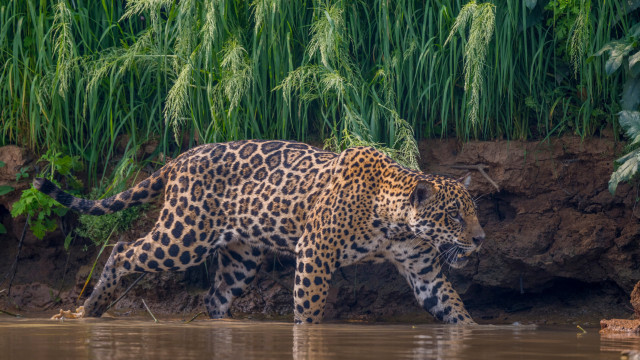

























© Getty Images
0 / 26 Fotos
Kinkajou - They may look adorable, but the kinkajous are actually quite aggressive. Apart from the fact they can tear apart all of the furniture, keeping this animals as a pet is tricky because the tropical environment they're used to is hard to replicate.
© Shutterstock
1 / 26 Fotos
Axolotl - Also known as the Mexican salamander, these animals serve as a great example for scientists to study body regeneration. Even though some people keep them as pets, they're an endangered species. Axolotl owners must have a male and female and learn how to properly take care of them so they can reproduce.
© Shutterstock
2 / 26 Fotos
Kaapori capuchin - If you adopt one of these guys, remember they like to hang out in big groups, which means a lone kaapori capuchin tends to become depressive. When they reach adulthood, they can also start showing aggressive behavior.
© Shutterstock
3 / 26 Fotos
Chimpanzee - Chimps are some of the most dangerous animals to keep as pets. Their cognition is pretty complex and their behaviors are hard to fully comprehend, making it hard to know how they'll react to certain stimuli.
© Shutterstock
4 / 26 Fotos
Desert fox - This canine fox can be kept as a pet and its behavior is quite similar to a dog. However, they need to be properly raised and educated, as they tend to escape!
© Shutterstock
5 / 26 Fotos
Squirrel monkey - They're kept as pets in many countries around the world, but these monkeys aren't the most hygienic to have at home... they use their own urine to wash their hands and feet!
© Shutterstock
6 / 26 Fotos
Sloth - Sloths are extremely adorable and friendly animals, however, they must follow a specific diet as they have sensitive stomachs and few vets know how to treat them.
© Shutterstock
7 / 26 Fotos
Elephants - It is legal to have a pet elephant in some places, as long as the requirements are fulfilled. But having one isn't easy on the wallet, as they eat tones of food every day.
© Shutterstock
8 / 26 Fotos
Common degu - Degus are friendly and sociable animals when they're domesticated early on. However, the fact they are so social means they need company, so consider having two of them.
© Shutterstock
9 / 26 Fotos
Serval - This big cat is kept as a pet in many countries and is typically not aggressive towards humans, however they are still wild animals with basic survival instincts which can make them hard to care for and domesticate.
© Shutterstock
10 / 26 Fotos
Emperor scorpion - In the last few years scorpions have become increasingly popular among wild pet owners. Even though they're not particularly dangerous (their sting hurts like a bee's), precaution is needed when dealing with these animals!
© Shutterstock
11 / 26 Fotos
Striped hog-nosed skunk - Do they make for good pets? Yes, but you must remember to have the glands responsible for a skunk's bad smell removed. This surgery must be done at a younger age.
© Shutterstock
12 / 26 Fotos
Bears - Yes, some people keep bears as pets - legally! However, it can be hard to keep up with their voracious appetite and sheer strength.
© Shutterstock
13 / 26 Fotos
Genet - These carnivores with a tail longer than their own body may be a good alternative to a cat. Yet, they're carnivorous nature can make them aggressive.
© Shutterstock
14 / 26 Fotos
Capybara - This one is a tricky pet to have. Capybaras are extremely social and need to be in groups almost constantly. Besides, they're semi-aquatic beings and most people won't be able to provide them that kind of habitat.
© Shutterstock
15 / 26 Fotos
South American horned frogs - Also known as the Pacman frog, this amphibian has become popular due to its association with the video game. Even though they look venomous, they're actually easy to take care of under the right circumstances.
© Shutterstock
16 / 26 Fotos
Chinchilla - Even though they may seem like an unusual pet, the chinchilla is probably the easiest wild animal to domesticate and find in pet shops.
© Shutterstock
17 / 26 Fotos
Wolf - Lots of people try to domesticate wolves as if they were dogs, but wild animals don't have the same perception of loyalty and are harder to train. If they're hungry or feel threatened, they'll simply attack.
© Shutterstock
18 / 26 Fotos
Bearded dragons - This species has also become increasingly popular the last few years. However, they're hard pets to keep as they need their habitat needs to be temperature-controlled habitat cleaned in a certain way. If you don't have the time or patience to look after them, then don't get one!
© Shutterstock
19 / 26 Fotos
Otters - The North American river otter can be kept as a pet, but it is a very agitated animal which can raise several problems at home.
© Shutterstock
20 / 26 Fotos
Tigers - Having a pet tiger is legal in some countries like the US, but there is no need to explain why this animal belongs in the wild, right?
© Shutterstock
21 / 26 Fotos
Wallaroo - This marsupial can be a good pet if raised by its owner from a young age, otherwise they can be quite aggressive.
© Shutterstock
22 / 26 Fotos
Python - This is the most popular species of pet snake in the US. However, there have been several cases in which pet pythons showed aggressive or even deadly behavior.
© Shutterstock
23 / 26 Fotos
Bobcat - Yes, it is legally possible to keep a pet bobcat in some countries, but it is also one of the most dangerous pets to have.
© Shutterstock
24 / 26 Fotos
Alligators
- This one is also pretty obvious. Alligators are predators and there is no real reason why someone would want to have them as pets!
© Shutterstock
25 / 26 Fotos
© Getty Images
0 / 26 Fotos
Kinkajou - They may look adorable, but the kinkajous are actually quite aggressive. Apart from the fact they can tear apart all of the furniture, keeping this animals as a pet is tricky because the tropical environment they're used to is hard to replicate.
© Shutterstock
1 / 26 Fotos
Axolotl - Also known as the Mexican salamander, these animals serve as a great example for scientists to study body regeneration. Even though some people keep them as pets, they're an endangered species. Axolotl owners must have a male and female and learn how to properly take care of them so they can reproduce.
© Shutterstock
2 / 26 Fotos
Kaapori capuchin - If you adopt one of these guys, remember they like to hang out in big groups, which means a lone kaapori capuchin tends to become depressive. When they reach adulthood, they can also start showing aggressive behavior.
© Shutterstock
3 / 26 Fotos
Chimpanzee - Chimps are some of the most dangerous animals to keep as pets. Their cognition is pretty complex and their behaviors are hard to fully comprehend, making it hard to know how they'll react to certain stimuli.
© Shutterstock
4 / 26 Fotos
Desert fox - This canine fox can be kept as a pet and its behavior is quite similar to a dog. However, they need to be properly raised and educated, as they tend to escape!
© Shutterstock
5 / 26 Fotos
Squirrel monkey - They're kept as pets in many countries around the world, but these monkeys aren't the most hygienic to have at home... they use their own urine to wash their hands and feet!
© Shutterstock
6 / 26 Fotos
Sloth - Sloths are extremely adorable and friendly animals, however, they must follow a specific diet as they have sensitive stomachs and few vets know how to treat them.
© Shutterstock
7 / 26 Fotos
Elephants - It is legal to have a pet elephant in some places, as long as the requirements are fulfilled. But having one isn't easy on the wallet, as they eat tones of food every day.
© Shutterstock
8 / 26 Fotos
Common degu - Degus are friendly and sociable animals when they're domesticated early on. However, the fact they are so social means they need company, so consider having two of them.
© Shutterstock
9 / 26 Fotos
Serval - This big cat is kept as a pet in many countries and is typically not aggressive towards humans, however they are still wild animals with basic survival instincts which can make them hard to care for and domesticate.
© Shutterstock
10 / 26 Fotos
Emperor scorpion - In the last few years scorpions have become increasingly popular among wild pet owners. Even though they're not particularly dangerous (their sting hurts like a bee's), precaution is needed when dealing with these animals!
© Shutterstock
11 / 26 Fotos
Striped hog-nosed skunk - Do they make for good pets? Yes, but you must remember to have the glands responsible for a skunk's bad smell removed. This surgery must be done at a younger age.
© Shutterstock
12 / 26 Fotos
Bears - Yes, some people keep bears as pets - legally! However, it can be hard to keep up with their voracious appetite and sheer strength.
© Shutterstock
13 / 26 Fotos
Genet - These carnivores with a tail longer than their own body may be a good alternative to a cat. Yet, they're carnivorous nature can make them aggressive.
© Shutterstock
14 / 26 Fotos
Capybara - This one is a tricky pet to have. Capybaras are extremely social and need to be in groups almost constantly. Besides, they're semi-aquatic beings and most people won't be able to provide them that kind of habitat.
© Shutterstock
15 / 26 Fotos
South American horned frogs - Also known as the Pacman frog, this amphibian has become popular due to its association with the video game. Even though they look venomous, they're actually easy to take care of under the right circumstances.
© Shutterstock
16 / 26 Fotos
Chinchilla - Even though they may seem like an unusual pet, the chinchilla is probably the easiest wild animal to domesticate and find in pet shops.
© Shutterstock
17 / 26 Fotos
Wolf - Lots of people try to domesticate wolves as if they were dogs, but wild animals don't have the same perception of loyalty and are harder to train. If they're hungry or feel threatened, they'll simply attack.
© Shutterstock
18 / 26 Fotos
Bearded dragons - This species has also become increasingly popular the last few years. However, they're hard pets to keep as they need their habitat needs to be temperature-controlled habitat cleaned in a certain way. If you don't have the time or patience to look after them, then don't get one!
© Shutterstock
19 / 26 Fotos
Otters - The North American river otter can be kept as a pet, but it is a very agitated animal which can raise several problems at home.
© Shutterstock
20 / 26 Fotos
Tigers - Having a pet tiger is legal in some countries like the US, but there is no need to explain why this animal belongs in the wild, right?
© Shutterstock
21 / 26 Fotos
Wallaroo - This marsupial can be a good pet if raised by its owner from a young age, otherwise they can be quite aggressive.
© Shutterstock
22 / 26 Fotos
Python - This is the most popular species of pet snake in the US. However, there have been several cases in which pet pythons showed aggressive or even deadly behavior.
© Shutterstock
23 / 26 Fotos
Bobcat - Yes, it is legally possible to keep a pet bobcat in some countries, but it is also one of the most dangerous pets to have.
© Shutterstock
24 / 26 Fotos
Alligators
- This one is also pretty obvious. Alligators are predators and there is no real reason why someone would want to have them as pets!
© Shutterstock
25 / 26 Fotos
Wild animals you probably shouldn't keep as pets
Some of these species definitely shouldn't be kept as pets, yet in some countries they are!
© Getty Images
Having a pet can be the best thing in the world: they keep you company, they're loyal and also fun to be around! However, they can also be quite difficult to look after, especially if they're wild.
Some people are really into keeping wild animals as pets, but there are reasons why you shouldn't - check them out!
RECOMMENDED FOR YOU




































MOST READ
- Last Hour
- Last Day
- Last Week








